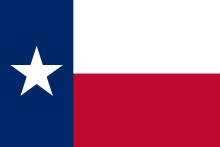- Foreign relations of the Republic of Texas
-
The Republic of Texas was a North American Nation from 1836-1845; in its short time it established diplomatical relations worldwide, mainly through the cotton trade.
Contents
Bilateral relations
Belgium
Texas had a consulate in Antwerp.[1]
Denmark
Denmark was very hesitant to recognize Texas at first, as it deemed its relations with Mexico a priority, and worried that recognition of Texas would violate the 1827 Treaty of Friendship, Trade and Navigation it had signed with Mexico.[2][dubious ] Denmark however, though not extending itself diplomaticly, did go as far allowing Texan Goods into Danish ports but would latter put a tariff on all imports from Texas. Aside from the almost one-way trading, relations between the two nations were almost non-existent.
- Trade between the two nations was minimal, but the Republic of Texas did however export some cotton and corn to Denmark and its colonies,[3] Denmark may have exported some wheat and finished goods to the Republic of Texas; however, this cannot be proven.[4] Trade did not last long before Denmark put a tariff on Texan goods.
Federated Republic of Central America
Main article: Federal Republic of Central America – Republic of Texas relationsIn 1823 Mexico's southernmost provinces secceded from the union forming a Federation of ther own.[5] Texas secceded in a much different fashion, and for different reasons, but with the same intention of being free from Mexican Rule. Thus the two nations were seen as destined for diplomacy but few missions were ever enacted, due to there differences in religion, language and ethics. Perhaps Texas' greatest influence over the Federation was the encouragement of nationalism, and in fact the strong feeling of nationalism Texas had was growing in The Central American Provinces, triggering the fragmentation of the Federation into five independent states.[6] Trade and relations between Texas and The former UPCA remained at a minimal, but Guatemala continued relations, and in 1845 was considering opening an embassy in Austin, Texas, however Texas was annexed by the United States before this was possible.
France
Main article: France – Republic of Texas relationsFrance was one of the few nations to grant official recognition of Texas on September 25, 1839. In 1841 The French opened an embassy in Austin, and Texas opened an embassy in Paris.[1]
Great Britain
- Texas had a consulate in London, Britain had a consulate in Houston. In 1845 Texas was in the process of applying for an embassy in London, The United States annexed Texas before this was possible, the British never intended to open an embassy in Austin.[7]
The British Empire had strong diplomatic relations with Mexico since 1824. When Texas secceded from Mexico, The Mexican government refused to recognize its sovereignty. The British Empire wanting to maintain its diplomacy with Mexico, thus denying recognition of the Republic of Texas.[8] The British went so far as to supply the Mexican Navy with Ironclad Warships,[9] at the same time, London Ports were secretly accepting Texan Goods.[10] Of all the reasons for refusal of recognization, none were so important as the practice of Slavery, which was outlawed throughout the British Empire, while the maintaining of slavery was one of the reasons for Texas' secession, thus creating an ethical divide between the two nations, solidifying Britain's stance on the Texas sovereignty issue.[11]
- The British Empire and the Republic of Texas, regardless of the former's refusal to recognize the latter as independent, imported and exported trade goods. The British allowed more imports than exports, Texan cotton was needed for textile work in England, some of the finished product that was sold world wide, found its way back to Texas on British ships.[12]
Mexico
Main article: Mexico – Republic of Texas relationsMexico never recogonized Texas' independence. Instead the Mexican government considered Texas a rebellious territory still belonging to Mexico. By 1838 Texas had a firm hold on its eastern lands, but the majority of Texas remained under Mexican control. Texas claimed the official southern and western border between the two countries to be the Rio Grande,[13] Mexico considered it a ridiculous compromise to even allow the eastern part of Texas to remain independent.
The Netherlands
It did not take long for the Netherlands to decide to open an embassy in Austin, in mimicry of Belgium. In response, Texas opened an embassy in Amsterdam.[7] France, Belgium and the Netherlands were the only three European nations to fully and officially recogonize Texas as a sovereign nation.[7]
- A marginal number of Dutch immigrants began to settle in Texas; however, the percentage of Dutch Texans would remain below 3% until after The Civil War and the end of the American Restoration, when Dutch majority towns, such as Nederland, began to pop up across the state.[14] Very few, if any Texans moved to Holland.
- Texas exported cotton, corn and other raw materials to the Netherlands, the Netherlands exported textiles, chocolate, beer and many other products to Texas.[15]
Russian Empire
Russia was one of the first Industrial Nations to recogonize the United States in 1776.[16] Russia would not even attempt diplomacy with Mexico until 1890. The United States had supported the Texas Revolution, and considered Texas a Sister State. Russia attempting to maintain its relations with the US, decided to recogonize Texas as an independent entity, until 1846 when The US decided to annex Texas, Russia fully supported the annexation. Neither nation built an embassy in each others capital, it is not known if either nation sent diplomats to each others country[17][dead link].
- Texas exported cotton, and potentially some corn to Russia, however the amount was minute in comparison to Western Europe.[11] Russia exported nothing to Texas, but did export wheat and grain to the United States,[18] some of this grain may have been traded to Texas, but this can not be proved.
United States
Main article: Republic of Texas – United States relationsIn 1831 The United States opened an embassy in Austin, in 1841 The Republic of Texas opened an embassy in Washington, DC.[19]
Republic of Yucatán
Main article: Republic of Texas – Yucatán relationsYucatán had an embassy in Austin, Texas had an embassy in Mérida.[20] Both insurgencies had tried to secceede from Mexico, and aided each other in disputes with Mexico. The Yucutan insurgency was unsuccessful.
Treaties of the Republic of Texas
Treaties of Velasco
Main article: Treaties of VelascoThe Treaties of Velasco were two documents signed at Velasco, Texas, (which is now Freeport, Texas) on May 14, 1836, between Antonio López de Santa Anna of Mexico and the Republic of Texas, in the aftermath of the Battle of San Jacinto (April 21, 1836). The signatories were Interim President David G. Burnet for Texas and General Santa Anna for Mexico. The Treaties were intended, on the part of the Texans, to provide a conclusion of hostilities between the two belligerents and offer the first steps toward the official recognition of the breakaway Republic's independence. However, there was a public treaty and a secret treaty, and the treaty was never ratified by the Mexican government. Moreover, the documents were not even called "treaties" until so characterized by U.S. President James K. Polk in his justifications for war some ten years later, as was pointed out by Congressman Abraham Lincoln in 1848.[21]
Treaty of Bird's Fort
Main article: Treaty of Bird's FortThe Treaty of Bird’s Fort, or Bird’s Fort Treaty was a peace treaty between the Republic of Texas and some of the Indian tribes of Texas and Oklahoma, signed on September 29, 1843.[22] The treaty was intended to end years of hostilities and warfare between the Native Americans and the white settlers in Texas. The full title of the treaty was “Republic of Texas Treaty with the Indigenous Nations of the Delaware, Chickasaw, Waco, Tawakani, Keechi, Caddo, Anadahkah, Ionie, Biloxi, and Cherokee.”[23]
Treaty of Tehuacana Creek
Main article: Treaty of Tehuacana CreekThe Treaty of Tehuacana Creek (or the Treaty of Peace, Friendship and Commerce) was signed at Tehuacana Creek on October 9, 1844 between representatives from the Republic of Texas and various Native American tribes. The tribes involved in the signing of the treaty were the Comanche, the Keechi, the Waco, Caddo, Anadarko, Ioni, Delaware, Shawnee, Cherokee, Lipan Apache, and Tawakoni tribes. Based on the terms of the treaty, both Native Americans and Texans agreed to cease all hostilities and establish more cooperative political and commercial ties. Texas violated the terms of all treaties. The Cherokee, Delaware, and Shawnee were driven out by unprovoked attacks. The Tonkawa were nearly exterminated. The Lipan were either driven to Mexico or took refuge with the Mexican population.
See also
- Diplomats of the Republic of Texas
- United States Ambassador to Texas
References
- ^ a b "CONSULAR SERVICE OF THE REPUBLIC OF TEXAS", Handbook of Texas, Texas State Historical Association, http://www.tshaonline.org/handbook/online/articles/mec02
- ^ "Collection of twenty-five treaties between Mexico and other nations made between 1825 and 1856, with an appendix containing another five treaties and documents involving the United States, Mexico and Latin American nations". Antiqurian Booksellers. http://www.abaa.org/books/193828015.html. Retrieved 4 August 2011.
- ^ Ethel Zivley Ratiler. "Recognition of the Republic of Texas by the United States". http://hiddenmysteries.com/xcart/product.php?productid=18637. Retrieved 4 August 2011.
- ^ "Europages: Crop services". http://www.europages.com/business-directory-europe/did-24/hc-21810/cc-DNK/Denmark/Crop-services.html. Retrieved 4 August 2011.
- ^ http://www.britannica.com/EBchecked/topic/616533/United-Provinces-of-Central-America
- ^ http://countrystudies.us/el-salvador/5.htm
- ^ a b c http://lovellslondonlist.com/Buildings/the-embassy-of-the-republic-of-texas.html
- ^ http://www.tsl.state.tx.us/exhibits/annexation/part3/question4.html
- ^ http://www.navyandmarine.org/ondeck/1839TexasNavy.htm
- ^ http://www.tshaonline.org/handbook/online/articles/mzr02
- ^ a b http://www.texasslaveryproject.org/sources/ROTDC/index.php
- ^ http://www.cah.utexas.edu/texashistory/annex/biblio.php?s=6
- ^ http://www.newworldencyclopedia.org/entry/Rio_Grande
- ^ http://www.genealogymagazine.com/dutch.html
- ^ http://www.sonofthesouth.net/revolutionary-war/world/dutch-esast-india-company.htm
- ^ http://www.zampwiki.com/?t=Russian_Empire_%E2%80%93_United_States_relations
- ^ http://gregor.us/relations/russia-republic-of-texas/
- ^ http://www.brill.nl/russias-foreign-trade-and-economic-expansion-seventeenth-century
- ^ http://www.tsl.state.tx.us/news/legation.html
- ^ A Century of Lawmaking for a New Nation: U.S. Congressional Documents and Debates, 1774 - 1875
- ^ Texas State Library and Archives Commission: Bird's Fort Treaty Ratification Proclamation, 1843
- ^ Texas Nationalist Movement: Treaty at Birds Fort
 Foreign relations of the Republic of Texas
Foreign relations of the Republic of TexasEmbassies Belgium • France • United States • Yucatán
Diplomats of the Republic of Texas Branch T. Archer • Barnard E. Bee, Sr. • Ashbel SmithTreaties of the Republic of Texas Treaties of Velasco • Treaty of Bird's Fort • Treaty of Tehuacana CreekCategories:
Wikimedia Foundation. 2010.

